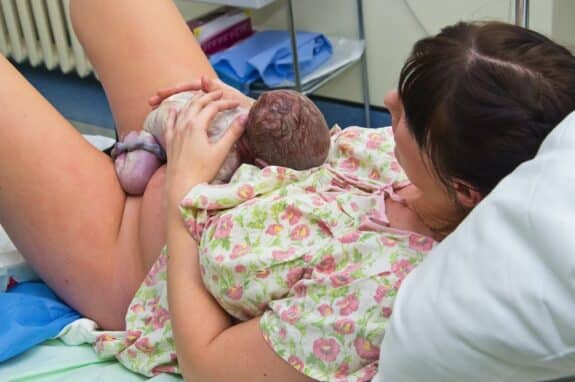If you’ve previously had a Cesarean section but would like to try to attempt a vaginal birth (VBAC) this time around, you may find that your odds of success are relatively high. In fact, a study recently published in BJOG: An International Journal of Obstetrics and Gynecology found that about two-thirds of women who attempted a VBAC were successful.
Conducted by the Office for Research and Clinical Audit (ORCA) at the Royal College of Obstetricians and Gynecologists and the London School of Hygiene & Tropical Medicine, the study aimed to investigate the success rate of vaginal births after cesarean, as well as what factors may change the chances of success. A total of 143,970 women who’d had their first baby by cesarean between 2004 and 2011 were included in this study – about half (52%) of which attempted a vaginal birth for their second baby.
According to the researchers, women 24 and younger were most likely to attempt a VBAC (60%), while women over the age of 34 were the least likely (45%). Additionally, black and Asian had a higher VBAC attempt rate than white women (62%, 64% and 49% respectively).
Of those that attempted a VBAC, almost two-thirds of them (63%) were successful at delivering their babies naturally. However, black women seemed to have a lower success rate when compared to white women (50% vs. 66% respectively), and women over age 34 had a lower success rate than those aged 24 or younger (59% vs. 69% respectively).
“The majority of women with an uncomplicated first cesarean section are candidates for attempting VBAC, but our data found that only half of these women chose this option,” Hannah Knight, Office for Research and Clinical Audit, Royal College of Obstetricians and Gynecologists, and lead researcher on the study, told Science Daily. “Women from a non-white ethnic background were more likely than white women to attempt a VBAC, but the success rate in non-white women was lower. This could point to different patient preferences or lack of access to elective repeat cesarean section for non-white women.”
Researchers also found that the reason for the first cesarean section made a difference in the odds of VBAC success. For example, women that had a history of failed labor inductions were almost twice as likely to have a failed VBAC than those with no history of labor induction failure. What’s more, there seemed to be an unexplained variation of VBAC attempts and success rate between hospitals – a variation that ranged anywhere from 33% to 94% in attempted VBACs and anywhere from 48% to 84% in successful vaginal deliveries.
“Interestingly, we also found an unexplained variation in the rate of attempted and successful VBAC between hospitals, which was independent of maternal demographic and clinical risk factors,” Knight said.
But despite these mystery variations, King says that their study should help provide some valuable information to both women and doctors wishing to know more about vaginal birth after cesarean.
“An informed discussion about whether or not to attempt a vaginal delivery after a cesarean section requires an assessment of the risk of emergency cesarean, and this paper provides valuable information for both women and the obstetricians and midwives caring for them,” she said.
“In England, approximately 50,000 women per year are faced with the choice of attempting a trial of labor after having a C-section for their first delivery,” John Thorp, BJOG deputy editor-in-chief added. “This study shows encouraging results with the majority of women who attempted a natural delivery after a primary C-section being successful. Current UK guidelines state pregnant women with a primary C-section and uncomplicated healthy second pregnancy should be given the option of a vaginal birth for their next baby, or an elective repeat C-section, and counseled on the risks and benefits of both. Women with any questions about their delivery options should consult with their midwife or obstetrician.”
Related Articles:
- “Cross-Fit Mom,” Lea-Ann Ellison Welcomes A Beautiful and Healthy Baby Boy!
- Paramedic Helps Talk Dad through Walmart Parking Lot Delivery
- A Series of Miracles Result in the Safe Delivery of Preemie Baby Maddox








I just had a homebirth VBAC after 3 csections with a 9lbs baby! It is possible to do it! I could not believe it myself!
I went to the chiropractor in my 2nd trimester, stayed active and ate right. And I took Gentle birth formula at 35 weeks. Plus, I prayed a lot so the Lord Jesus would take any fear away from my heart, which could affect my labor. It was the shortest labor yet (5 hours) with my biggest baby with no tear. When I think that my previous doctor told me while doing my csection that it would be better to get my tubes tied because my uterus was really thin! Do not lose hope because we were made to do this. No doctor was considering me as patient, but a wonderful midwife took a chance on me and I gave birth with my family in my own bed.
Doris,
That is wonderful! I’m so glad you finally had a chance to experience vaginal birth and its benefits – even better that you were able to do so at home with your family. I’m amazed at how brave you were to give it a shot after having 3 C-sections! More than that, you fought for the chance to have a vaginal birth and searched for a practitioner that would work with you. Congratulations on the amazing and safe delivery. <3
I think the problem here is that many doctors aren’t open to letting women who have delivered by c-section try a vaginal birth the second time around. I wanted to try and my OB said no.